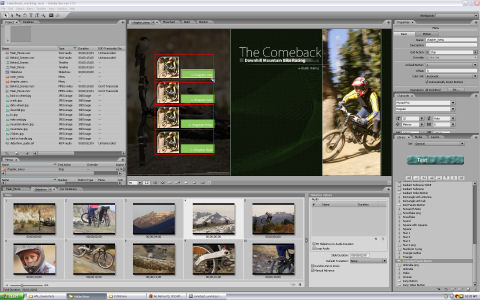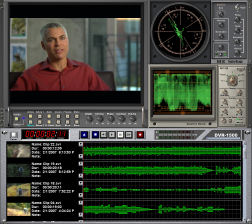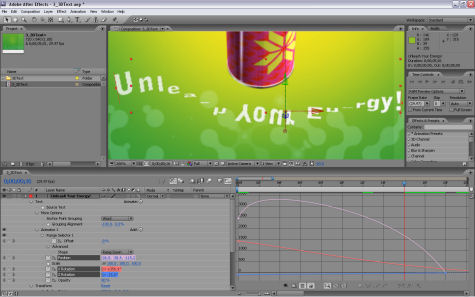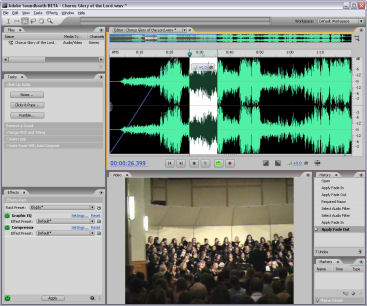Manifest Technology Blog
-- Site:
| Articles
| Galleries
| Resources
| DVI Tech
| About
| Site Map
|
Articles:
| PC Video
| Web Media
| DVD & CD
| Portable Media
| Digital Imaging
| Wireless Media
| Home Media
| Tech & Society
|
PC Video: |
PC Video Articles |
Video Software Gallery |
Video Editing Resources |
Adobe Creative Suite 3:
Applications, Suites, New Features (8/2007)
by Douglas Dixon
Applications and Suites
Products and Pricing
Adobe Premiere Pro CS3
Adobe Encore CS3
Adobe OnLocation CS3
Adobe After Effects CS3
Adobe Soundbooth CS3
Adobe Device Central CS3
Get Creative




Adobe Creative Suite 3 - Design - Web
- Production - Master Collection
The next generation of Adobe's design and development tools shipped in March
and July as Adobe Creative Suite 3 (www.adobe.com/products/creativesuite).
This is a tremendous accomplishment of software development for Adobe, just
in releasing new versions of some 13 major applications on its regular
two-year product cycle, with major new features, more common interfaces, and
stronger integration for moving content between applications.
But Adobe has done even more, not only also porting the video tools including
Premiere Pro and Encore back to the now Intel-based Macintosh platform,
but also assimilating the purchase of Macromedia half-way into the
development cycle to add Web design tools to the suite and provide integration
with Flash video and animation. Oh, and the video suites also include two more
exciting tools from the acquisition of Serious Magic.
There's obviously a lot to digest here, so let's take a look at it from
several different points of view -- organizing the applications into categories
and suites, the actual products and prices, and the individual tools and their
new features.
And there's a lot to cover with some 13+ applications in
Adobe Creative Suite 3, so we'll focus on some of the new highlights of the
video design and development tools in the Production suite.
- See Adobe
Creative Suite 3: Summary for an overview of the applications,
suites, and pricing.
- See Adobe Creative Suite 3: Production Suite Summary
for summaries of the Production tools. - See Adobe
Soundbooth: Audio for Video for an overview of the new audio tool.
- See Deliver Everywhere: Adobe's
Creative Suite 3 for examples of delivering content across many
channels.
 Find Adobe
Creative Suite 3 Master Collection (Windows or Mac) on Amazon.com
Find Adobe
Creative Suite 3 Master Collection (Windows or Mac) on Amazon.com
 Find Adobe
Creative Suite 3 Production Premium (Windows or Mac) on Amazon.com
Find Adobe
Creative Suite 3 Production Premium (Windows or Mac) on Amazon.com
Adobe has organized its creative tools into three main categories: Design
tools for print, web, interactive and mobile design and publishing (e.g.,
Photoshop, Illustrator, InDesign); Web design and development tools
(e.g., Dreamweaver and Flash), and Production tools for video,
post-production and rich media (e.g., Premiere Pro and After Effects).
- See Adobe
Creative Suite 3: Summary for an overview of the applications,
suites, and pricing
You can still buy the tools individually, although Adobe has simplified
things a bit by including Encore (for DVD) and OnLocation (DV capture) with
Premiere. But Adobe has also created Design, Web, and Production bundles
that combine all the major tools in each area, at the price of only two of the
tools. The Design and Web suites also come in a Standard version, and a Premium
version that adds almost all the tools from the companion suite for full Design
plus Web work -- after all, almost everybody uses Photoshop and Illustrator,
whether for print, video, DVD, or Web.
Finally, there's the full Master Collection site, with every single
one of these tools, because today's designers are generalists that end up
working in all media -- designing and delivering across print, video, and Web.
For example, editing photos and graphics for video overlays, DVD menus, and Web
animations; then editing video and exporting to the Web.
The Design suite features Adobe Photoshop CS3 for image
editing, Illustrator for illustration and vector graphics. InDesign for
professional layout and design, and Acrobat 8 Professional for PDF
documents. The Design Premium suite upgrades Photoshop to Photoshop
CS3 Extended with support for 3D and video, and adds Dreamweaver and Flash.
The Web suite features Adobe Flash CS3 Professional for
interactive design, Dreamweaver for website design, Contribute for
Web publishing, and Fireworks to optimize images for the Web. The Web
Premium suite adds Acrobat, Photoshop CS3 Extended, and Illustrator.
If you're primarily focused on non-video and Web design, the only differences
between the Design Premium suite and the Web Premium suite is that Web does not
include InDesign, and Design does not include Contribute and Fireworks.
The Production suite comes in one Premium version, and features Adobe
After Effects CS3 Professional for motion graphics and visual effects, Premiere
Pro for video editing for HD, SD, and DV, Soundbooth for audio
enhancement and creation (replacing Audition), and Encore for DVD. It
also adds two former Serious Magic tools for Windows only, Adobe OnLocation
CS3 for direct-to-disc recording and monitoring (was DV Rack), and Ultra
for video keying. Plus, the suite adds Photoshop CS3 Extended, Illustrator,
and Flash. However, the Production suite does not include Acrobat or
Dreamweaver -- for those you should step up to the Master Collection.
- See Adobe Creative Suite 3: Production Suite Summary
for summaries of the Production tools
The Adobe suites also include additional major components, not so much
independent applications as components that are designed for integration and
collaboration, including Adobe Bridge CS3, a navigational control center,
Acrobat Connect for online collaboration, Adobe Stock Photos to
access royalty-free images, Version Cue to collaborate on document
versions, the new Device Central to preview mobile content, and Adobe
Dynamic Link to interchange without rendering between After Effects,
Premiere, and Encore. Some of these are included with the individual
applications, while others like Version Cue and Dynamic Link only make sense as
part of a suite of integrated applications.
Top
That's a lot of products, and Adobe wants you to use them all as an
integrated suite, offering the bundled suites at significant discounts, as well
as upgrade pricing from previous versions of its products and suites.
- See Adobe
Creative Suite 3: Summary for an overview of the applications,
suites, and pricing.
For Design work, you can buy individual copies of Photoshop (US $649
list) and Illustrator ($599), and InDesign ($699), or step up to the Design
Standard suite ($1199) with Acrobat ($449). Or move up to the Design Premium
suite ($1799) with Photoshop CS3 Extended ($999), the Web tools, and components
including Version Cue.
For Web work, you can start with Flash ($699) and Dreamweaver ($399),
or step up to the Web Standard suite ($999) with Contribute ($149) and Fireworks
($299). Or move up to the Web Premium suite ($1599) with the Design tools.
And for Production work, you can buy individual copies of After
Effects ($999), Premiere Pro ($799, including Encore, OnLocation, and Ultra) and
Soundbooth ($249), or move up to the Production Premium Suite ($1699), with
Design and Web tools, and components including Dynamic Link.
Or take the big gulp -- all the Adobe creative tools in the Master
Collection suite ($2499) -- 13+ major applications and 6+ additional
components that integrate together to get you from 2D to 3D, graphics to images,
static to motion, print to video to Web.
The Adobe Creative Suite 3 Design and Web tools shipped at the end of March
2007, and the Production tools shipped in July.
The CS3 suite is now cross-platform. Many of the flagship Adobe tools like
Photoshop, Illustrator, and After Effects were already available on the Mac, and
so the majority of the CS3 tools are available as Universal applications for
both PowerPC and Intel-based Macintosh, and for Microsoft Windows XP and Vista.
The Production tools ported back to the Mac (besides After Effects) will be
available on Intel-based Mac systems, where they can leverage the processor
optimizations for video playback and effects. The exemptions are the two tools
added late in the cycle from Serious Magic, OnLocation and Ultra. On the Mac,
camera monitoring with OnLocation requires Boot Camp and Windows (purchased
separately), or a separate Windows based computer, and the current version of
Ultra really is designed as a Windows-only keying application.
Top
Adobe Premiere Pro is the central tool to capture, edit, and deliver
video to disc, the web, and mobile devices (www.adobe.com/products/premiere).

Project management has been improved with multiple project panels and
bins with smart file filtering. Editing efficiency has been enhanced with the
ability to replace a clip in the timeline while preserving the original's
attributes and effects (great for using one project as a template for new
versions).
Premiere also can play audio immediately in nested sequences without
rendering, and adds new Spectral Design audio filters to reduce noise, control
dynamics, and tweak EQ and compression.
Premiere Pro also has improved slow-motion and variable-speed control
features, with Time Remapping for variable-rate time stretching directly in
timeline, so you can change clip duration and pace to fit a sequence's timing
and beats. You get variable-speed slow motion and backward playback, with
real-time feedback and keyframe control.
Premiere Pro now exports directly to Flash video (FLV), with timeline
markers converted into Flash cue points to trigger interactivity during
playback. And for output to mobile devices, Adobe Media Encoder exports
H.264 and 3GPP video optimized for playback on mobile phones, Apple iPod, Sony
PSP, and other devices, with Adobe Device Central to simulate playback on
specific devices.
Premiere Pro also now includes Encore to export to DVD, Blu-ray Disc,
and Flash (instead of a build-in simple DVD exporter), OnLocation for
on-set monitoring and direct to disc recording, and Ultra for greenscreen
keying.
Oh, and there's the other detail that Premiere Pro and Encore are now
available for Intel Macs as well as Windows XP / Vista.
Adobe Encore is designed for authoring professional-quality DVDs, now
also in Blu-ray Disc format and direct to Flash (www.adobe.com/products/premiere/encore).
It's now bundled with Premiere Pro as the DVD export tool.

The key addition to Encore for disc authoring is support for the
high-definition Blu-ray Disc format. You can author a single project with
high-def content, and export both as standard-definition DVD and high-def Blu-ray
Disc.
In addition, you can also export your DVD production from Encore in Flash
SWF format -- the entire DVD playback experience, complete with menus,
interactivity, and video content, without scripting and without Flash authoring
-- ready to post on the Web and accessible to the 95%+ of Web users who have the
Flash player.
Adobe OnLocation is a new version of Serious Magic DV Rack HD for on-set
video monitoring and direct to disk capture (www.adobe.com/products/premiere/onlocation).
It's also bundled with Premiere Pro. However, it's a Windows application,
and therefore requires Boot Camp on a Macintosh running under Windows.

Use OnLocation for step-by-step camera calibration, and to monitor
recording quality, especially video and audio distortion. Check video levels
with the virtual reference monitor, waveform and vectorscope, View underscan,
safe-area, variable aspect ratios; with split-screen and dual-zebra modes. There's
also an audio spectrum analyzer.
OnLocation also provides direct-to-disk recording (which saves time-consuming
capturing from tape). Record DV and HDV directly from FireWire camera even to a
laptop hard drive. There's a pre-record buffer of up to 30 seconds to capture
video from before you press the Record button. Also record stop-motion animation
or time-lapse sequences.
Top
Adobe After Effects is the go-to tool for motion graphics and visual
effects, spanning film, video, DVD (i.e., motion menus), the Web, and also
mobile devices (www.adobe.com/products/aftereffects).

The new CS3 version adds Shape Layers for Illustrator-like vector
graphic creation directly within After Effects, plus text animation of
individual characters in 3D. The amazing new Puppet tool provides a
simplified approach to squash-and-stretch animation of 2D images: just add a few
push-pin control points, and drag with the mouse in real time to record
keyframed animations. And the new Brainstorm interface helps experiment
with animation options by presenting a grid of variations previewing in real
time, so you can click and repeat to refine the look.
After Effects also adds the Adobe Clip Notes tool from Premiere Pro
for review and approval: Export a composition as a PDF file, the reviewer can
play and annotate it with Adobe Reader, and the remarks are saved as timecode
clip markers for further collaboration and editing.
After Effects is even more strongly integrated with the other Adobe tools.
With Photoshop, create and animate Photoshop Layer Styles, import Photoshop 2D
Vanishing Point images to create animated 3D scenes based on the photo's shapes
and textures, and use new Photoshop CS3 Extended video layers for rotoscoping
and animated paint. And with Flash, import Flash SWF files, rasterize Flash
vector shapes and preserve alpha channels, export After Effects keyframes as
Flash cue points, and batch render Flash video files, exporting multiple formats
in one render pass.
Top
Adobe Soundbooth is a new tool for everyday audio editing and cleanup,
sound design, and music creation. It replaces Adobe Audition in the suite as an
audio tool designed for video editors, web developers, motion graphics artists,
and creative pros (www.adobe.com/products/soundbooth).

Adobe Audition continues as an independent high-end audio editing tool
on a separate development schedule (www.adobe.com/products/audition).
The new Audition 3 was announced in September, and is due before the end of the
year.
- See Adobe Soundbooth: Audio for Video
for an overview of this new audio tool
Soundbooth offers direct audio editing with on-clip controls for trim,
fade, and volume control, plus fast audio cleanup tools for common issues
including removing background noise, hiss, rumble, clicks, and pops. Then apply
more than 15 audio filters with presets, and stack up to five filters in
the Effects Rack and preview in real time.
In addition to improving recorded tracks, you can also create customized
music using AutoComposer with customizable Soundbooth Scores,
adjusting the length, mood, and instrumentation to match your production, with
keyframing. Adobe will provide an online Resource Central to browse additional
sound effects and Soundbooth Scores.
Adobe released the Soundbooth AutoComposer Toolkit in August, to
produce your own Soundbooth Scores (www.adobe.com/devnet/soundbooth).
Top
Adobe Device Central is a new component to preview exported content
for mobile devices from a variety of the Adobe tools (www.adobe.com/products/creativesuite/devicecentral).
It is designed to preview, test, and optimize mobile content on simulated
mobile and handheld devices, including video and images, and Web and Flash Lite
content.

It uses a library of devices with detailed specifications and
supported content types, and then simulates playback on selected devices,
including the appearance, performance, and behavior.
Device Central also emulates device memory, backlit screens in bright
sunlight, and low-battery conditions, and you can use the emulated keypad to
interact with Flash Lite content.
- See Deliver Everywhere: Adobe's
Creative Suite 3 for examples of delivering content across many
channels
Top
The new Adobe Creative Suite 3 is an impressive accomplishment,
bringing together leading applications, now even more tightly integrated and
with astounding new capabilities to move from 2D to 3D, stills to motion,
visuals to video to Web. There's obviously a lot more that we could cover in
these and the other Adobe applications, but there will be more time for that
when the Production tools ship.
Visit the Adobe website for more information on the products, extensive
online documentation and resources for designers and developers, the , and to
download trial versions of the applications (www.adobe.com/products/creativesuite).
Also check out the Adobe developer information, forums and blogs, and the Adobe
Exchange to share templates (www.adobe.com/cfusion/exchange).
In addition, Adobe has become even more open about its plans, so you can get
a head start on new developments. For CS3, Adobe pre-announced the move back to
the Mac platform and even released details of upcoming official
announcements.
And check out the Adobe Labs site, with free public betas of new
technology and application releases (labs.adobe.com),
not only for new applications like Soundbooth, but also with prerelease versions
of Premiere Pro and After Effects.
|
Adobe Creative Suite 3 Design and Web suites shipped in April
2007, and the Production tools shipped in July. |
Top
Originally published in Camcorder & Computer
Video magazine, 23, 4, August 2007.
|
